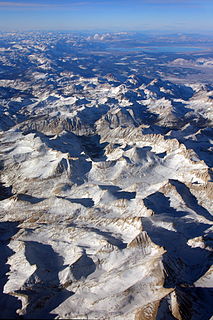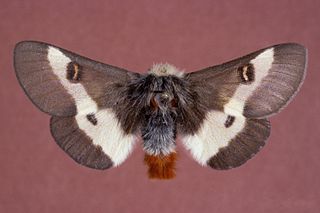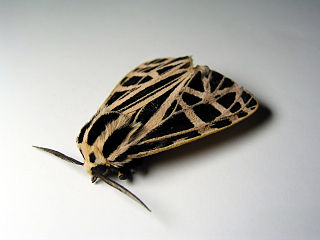
The Sierra Nevada is a mountain range in the Western United States, between the Central Valley of California and the Great Basin. The vast majority of the range lies in the state of California, although the Carson Range spur lies primarily in Nevada. The Sierra Nevada is part of the American Cordillera, an almost continuous chain of mountain ranges that forms the western "backbone" of the Americas.

Pisum is a genus of the family Fabaceae, native to southwest Asia and northeast Africa. It contains one to five species, depending on taxonomic interpretation; the International Legume Database (ILDIS) accepts three species, one with two subspecies:

Adiantum, the maidenhair fern, is a genus of about 250 species of ferns in the subfamily Vittarioideae of the family Pteridaceae, though some researchers place it in its own family, Adiantaceae. The genus name comes from Greek, meaning "unwetted", referring to the fronds' ability to shed water without becoming wet.

Hesperia, the branded skippers, is a Holarctic genus in the skippers (Hesperiidae) butterfly family. Most species are endemic to North America, Hesperia comma is widespread throughout the region. H. florinda is endemic to temperate eastern Asia. H. nabokovi is endemic to Hispaniola.

The buck moth is a common insect found in oak forests, stretching in the United States from peninsular Florida to New England, and as far west as Texas and Kansas. It was first described by Dru Drury in 1773. The larvae typically emerge in a single generation in the spring. The larvae are covered in hollow spines that are attached to a poison sac. The poison can cause symptoms ranging from stinging, itching and burning sensations to nausea. Subspecies Hemileuca maia maia is listed as endangered in the US state of Connecticut.

Glyptopleura is a genus of North American plants in the dandelion family. The common names for this plant include carveseed, holy dandelion, keysia, and crustleaf.

Ctenucha is a genus of moths in the family Erebidae.

Grammia is a genus of tiger moths in the family Erebidae. The genus was described by Rambur in 1866.

Diguetia is a genus of coneweb spiders that was first described by Eugène Simon in 1895. Members of this genus are six-eyed spiders that are either white or patterned. They are common in the southwestern United States and Mexico, and one species is found in Argentina. In the United States, species have been found in Arizona, California, Nevada, New Mexico, and Texas. These spiders build a tubular retreat at the tip of their tent-like webs. Once an insect is caught in the web, the spider bites it and injects venom to stop its prey from moving, later wrapping it in silk. Both males and females use stridulation while mating, with females also stridulating when harassed. Two species of jumping spiders feed on its eggs. There are eleven Diguetia species.

Leptarctia is a monotypic tiger moth genus in the family Erebidae described by Stretch in 1872. Its only species, Leptarctia californiae, was described by Francis Walker in 1855. It is found in western North America, from New Mexico and Colorado to California and north to British Columbia. The habitat consists of open forests, meadows and clearings in the mountains.

Lophocampa is a genus of moths in the family Erebidae. The genus was erected by Thaddeus William Harris in 1841. It contains around 75 species.
Mojavia is a monotypic moth genus of the family Crambidae erected by Eugene G. Munroe in 1961. It contains only one species, Mojavia achemonalis, which was first described by William Barnes and James Halliday McDunnough in 1914. It is found in North America, where it has been recorded from Arizona, California, Nevada, New Mexico and Texas.

Cahela is a monotypic snout moth genus described by Carl Heinrich in 1939. Its only species, Cahela ponderosella, the cahela moth, described by William Barnes and James Halliday McDunnough in 1918, is found in Mexico and in the US states of California, Texas, Arizona, Utah and probably Nevada.
Dioryctria hodgesi is a species of snout moth in the genus Dioryctria. It was described by Herbert H. Neunzig in 2003 and is known from Nevada and south-eastern California in the United States.
Dioryctria westerlandi is a species of snout moth in the genus Dioryctria. It was described by Julian P. Donahue and Herbert H. Neunzig in 2002 and is known from the US state of California, but the range may extend into Nevada.
Meroptera nevadensis is a species of snout moth in the genus Meroptera. It was described by Herbert H. Neunzig in 2003 from Elko County, Nevada in the United States. Its species epithet references the state of Nevada. The species is also found in Arizona and California.

Ctenucha brunnea, the brown ctenucha or brown-winged ctenucha, is a moth of the family Erebidae. The species was first described by Richard Harper Stretch in 1872. It is found in the US from central to southern coastal California.
Euchaetes elegans, the elegant pygarctia, is a moth of the family Erebidae. It was described by Richard Harper Stretch in 1874. It is found in the US states of California, Arizona, New Mexico, Nevada and Texas, and in Mexico, Guatemala, Panama and Colombia.
Grammia behrii is a moth of the family Erebidae. It was described by Stretch in 1872. It is found from Oregon south to California. It is most common in the Siskiyou and Sierra Nevada ranges. The habitat consists of dry lithosol flood plains and balds in the mountains.

Dorcadion fulvum is a species of beetle in the family Cerambycidae. It was described by Scopoli in 1763, originally under the genus Cerambyx. It is known from Austria, Bosnia and Herzegovina, Romania, Moldova, the Czech Republic, Hungary, North Macedonia, Bulgaria, Poland, Albania, Slovakia, Croatia, Slovenia, Serbia, and Ukraine.












